FAU Bureaus
Friends of African Union will create on the back of the Trans-Pacific Partnership (TPP) a trade agreement among with Pacific Rim countries to expand an alliance with African Americans worldwide based on the creation of national bureaus to represent the members of the African Diaspora in each country. Members of racial and ethnic minority groups are projected to become the majority of America’s population in the next 30 years. Today, however, they account for just 28 percent of America’s STEM workers. We know that for America to remain competitive in a global economy, we need to do all we can to draw upon the nation’s diverse talent pool, which includes historically underrepresented groups in STEM, such as women and minorities – our focus is on African Americans and Africans.

Through the FAU Chamber of Commerce will join His Royal Majesty’s already established Americans, Africa Asia Foundation.
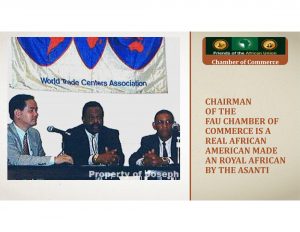
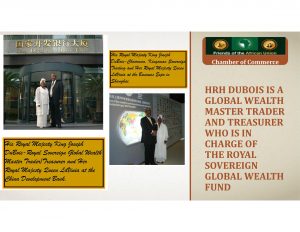
Africans traded with Chinese merchants and royal emissaries during the Sung (1127-1279) and Ming (1368-1644) dynasties. During the early 15th century the admiral Cheng Ho-an enslaved Muslim Chinese eunuch—led a series of seven imperial expeditions across the Indian Ocean; in 1415 his fleet brought a giraffe from Somalia, which Chinese court artists later painted in majestic fashion, so impressed were they by the kirin, as they called it (derived from the Somali word for giraffe, giri). Chinese porcelain dating from this period, and earlier, has been found in the walls of mosques and buildings along the East African coast. Although Chinese sailors and merchants had long made contacts with East Africans, it is not known whether Africans traveled to China prior to the rise of Portuguese naval power in the late 15th century.
Portuguese enlisted the services of Africans as sailors over the course of two centuries; some traveled as part of crews to China. In addition to ivory, tortoise shells and rhino horn from East Africa, some Africans were taken to China—mostly females, who were made concubines. African men also served as soldiers. In 1622 they defended the Portuguese base of Macau from Dutch attacks. That year, despite the seemingly overwhelming force of 13 Dutch ships and 1,300 soldiers, approximately 100Africans were given arms and, along with another 100 residents, repelled the Dutch.
Africans traveled aboard Portuguese ships to Japan. They manned 2,000-ton carracks—three- and four-masted ships—especially after the Portuguese purchased Macau in 1557. These black sailors of the Indian Ocean traveled between Goa, Macau and Nagasaki; some of the African crewmen are depicted in Western attire in nanban byobu, Japanese paintings from the period of Portuguese contact.
Enslaved Africans were not only sailors, and in the case of women, concubines, but served as interpreters as well. While in Macau during the early 17th century, the English traveler Peter Mundy noted two “Abbasin [Abyssinians]”—Chincheo and Antonio—both of whom had run away from the Portuguese and had since become Cantonese interpreters. These Africans, like others in the Indian Ocean world, spoke languages in addition to their own and Swahili. Swahili, with a Bantu grammar and many Arabic words, served as a lingua franca for many enslaved Africans—a kind of bridge between the various linguistic and ethnic origins among captives in East Africa as well as those who crossed the Indian Ocean.
The “Belanda Hitam,” or “Black Dutchmen,” was the Malay name given to the 3,000 Ghanaians recruited by the Dutch colonial army between 1831 and 1872 to fight in Indonesia. The Asante kingdom of Ghana supplied the predominantly Kuma recruits whom they had enslaved. To avoid the charge of slave trading, the Dutch created a system of offering the enslaved Africans the opportunity to purchase their freedom using advance payment for their future military service. They were taken to Elmina on the Ghanaian coast and received a certificate of manumission upon payment, which went to the Asante. The recruits were then trained at Fort Saint Jago before departing on the long journey to Indonesia.
Typically, the soldiers were recruited at the age of 16 and worked until 30. Upon completion of their service, they were given the option of returning to Ghana. A number of veterans did return and settled down in the area of Elmina with a plot of land given to them by the Dutch governor. Others stayed in Indonesia and married local women, forming communities of their own in garrison towns at Java (Batavia), Purworejo, Solo and Semarang.
We will build each trade agreement based on the text of the Trans-Pacific Partnership which was concluded by 12 Pacific Rim countries and was published in November 2015 in a version, “subject to to Legal Review in English, Spanish and French for Accuracy, Clarity and Consistency” and “Subject to Authentication of English, Spanish and French Versions”
The finalized Trans-Pacific Agreement proposal was signed on 4 February 2016 in Auckland, New Zealand, concluding seven years of negotiations. It is currently awaiting ratification to enter into force. The 30 chapters of the agreement aim to “promote economic growth; support the creation and retention of jobs; enhance innovation, productivity and competitiveness; raise living standards; reduce poverty in the signatories’ countries; and promote transparency, good governance, and enhanced labor and environmental protections.” The TPP contains measures to lower both non-tariff and tariff barriers to trade, and establish an investor-state dispute settlement mechanism.
A 2016 study by University of Maryland political scientists Todd Allee and Andrew Lugg finds that out of the 74 previous trade agreements that TPP members signed since 1995, the text of the TPP most resembles that from earlier U.S. trade agreements
Most international agreements in the United States are approved using Trade Promotion Authority (also called fast track) authorization, in which the US congress is required to hold a yes/no vote on any agreements without modification. The US passed a law agreeing to this fast-track procedure in 2015.
The terms of the TPA stipulate that when a deal is formally submitted to Congress, they must act within 90 legislative days. According to Politico, many expect Congress to vote on the bill either during the Summer of 2016 or in the lame-duck session after the 2016 elections. However, in August 2016, Senate Majority Leader Mitch McConnell (R-KY) stated that the vote will not occur that year but added, “It will still be around. It can be massaged, changed, worked on during the next administration.”
On October 14, 2009, President Obama signed an executive order that restores the White House Initiative and President’s Advisory Commission on Asian Americans and Pacific Islanders to address issues concerning the Asian American and Pacific Islander (AAPI) community – NOTICE NO SUCH FOR AFRICANS.
- Remarks by the President at the Executive Order Signing
- Infographic about the Initiative’s work
- Report from the President’s Advisory Commission, August 2014
- Grants, training, and resources to help AAPI organizations connect to federal opportunities
- Data.gov/AAPI – government data on the AAPI community
- Regional Network – connecting local AAPI communities to federal resources
- E3! Ambassadors – youth engagement program
- Task Force on New Americans (available in Chinese, Korean, Tagalog, and Vietnamese)
- Affordable Care Act videos (Korean, Vietnamese, Chinese, Burmese, Hmong, Khmer, Lao)
- Watch a video about educational institutions that serve Asian Americans and Pacific Islanders
- Resources for AAPI-owned businesses
Remarks by President Obama at Opening Session of the U.S.-ASEAN Summit
REMARKS BY PRESIDENT OBAMA
AT OPENING SESSION OF THE U.S.-ASEAN SUMMIT
Sunnylands Center
The Annenberg Retreat at Sunnylands
Rancho Mirage, California
3:47 P.M. PST
PRESIDENT OBAMA: Good afternoon, everyone. It is my privilege to welcome you to this landmark gathering — the first U.S.-ASEAN Summit hosted by the United States. This reflects my personal commitment, and the national commitment of the United States, to a strong and enduring partnership with your 10 nations individually and to Southeast Asia as one region, as one community — ASEAN.
I want to thank my co-chair, President Choummaly of Laos; Secretary General Minh; and leaders from all 10 ASEAN nations for being here.
As everyone knows, I first came to know the people and the beauty and the strength of Southeast Asia as a boy when I lived in Indonesia for several years with my mother. As President, I’ve had the opportunity to visit most of your countries. You and the people of ASEAN have always shown me extraordinary hospitality, and I hope we can reciprocate with the warmth today and tomorrow — which is why I did not hold this summit in Washington. It is cold there. It’s snowing. So, welcome to beautiful, warm Sunnylands. (Laughter.)
As President, I’ve insisted that even as the United States confronts urgent threats around the world, our foreign policy also has to seize on new opportunities. And few regions present more opportunity to the 21st century than the Asia Pacific. That’s why, early in my presidency, I decided that the United States, as a Pacific nation, would rebalance our foreign policy and play a larger and long-term role in the Asia Pacific. And this has included engagement with Southeast Asia and ASEAN, which is central to the region’s peace and prosperity, and to our shared goal of building a regional order where all nations play by the same rules.
As part of our deeper engagement, I’m proud to be the first U.S. President to meet with leaders of all 10 ASEAN countries. This summit marks our seventh meeting. At your invitation, the United States joined the East Asia Summit, and together we’ve made it the region’s leading forum for addressing political and security challenges. I’ve made now seven visits to the ASEAN region — more than any previous American President. At our last meeting in Kuala Lumpur, we forged a new Strategic Partnership. And our sustained engagement is delivering concrete results that benefit all of us — momentum that we can build on here at this summit.
Together, we can continue to increase the trade and economic partnerships that create jobs and opportunity for our people. Since I took office, we’ve boosted trade between the United States and ASEAN by 55 percent. The region is now our fourth largest goods trading partner, including U.S. exports that support more than 500,000 American jobs. U.S companies have been the largest source of foreign investment in ASEAN — one of the many reasons that the region’s GDP has surged in recent years, lifting people from poverty into the middle class.
I want to take this opportunity to again congratulate my fellow leaders on the formation of the ASEAN Community, which is another important step toward integrating your economies. Here at this summit, we can build on this progress and do more to encourage entrepreneurship and innovation so that growth and development is sustainable and inclusive and benefits all people.
Together, we can also continue to increase our security cooperation to meet shared challenges. In recent years, the United States has increased our maritime security assistance to our allies and partners in the region, improving our mutual capabilities to protect lawful commerce and to respond to humanitarian crisis. Here at this summit, we can advance our shared vision of a regional order where international rules and norms, including freedom of navigation, are upheld and where disputes are resolved through peaceful, legal means.
Together, we can continue to support the aspirations and dignity of our citizens. The historic election in Myanmar and the transition now underway gives hope for a nation that is inclusive, united, peaceful and democratic. In joining the TPP, Singapore, Vietnam, Malaysia and Brunei have committed to high labor and environmental standards.
I’m very proud that our Young Southeast Asian Leaders Initiative is helping to empower young men and women who are shaping the region every day. As you know, I’ve held a number of town hall meetings with these remarkable young people. And their idealism, their courage, their willingness to work for the future that they believe in should all give us hope. As leaders, we have to answer their aspirations. And here at the summit, we can reaffirm that strong, prosperous and inclusive societies require good governance, rule of law, accountable institutions, vibrant civil societies, and upholding human rights.
Finally, together, we can continue to do more around the world to meet transnational challenges that no one nation can meet alone. As we were reminded again by the attack in Jakarta last month, the scourge of terrorism demands that we stay vigilant, share more information and work cooperatively to protect our people. Just as our nations worked together to achieve a strong climate change agreement in Paris, now we need to implement that agreement and step up investment in clean, affordable energy, including for developing countries.
So, economic growth that is inclusive, creating opportunity for all; mutual security and the peaceful resolution of disputes; human dignity, including respect for human rights and development that is sustainable — that is our vision. That’s what brings us here together today.
I want to thank all of my fellow leaders for being here and for your commitment to a strong U.S.-ASEAN partnership. And given the extraordinary progress that we’ve achieved together these past seven years, I’m confident that we can continue our momentum at this summit.
With that, I want to invite President Choummaly to say a few words as well.
END 3:55 P.M. PST

Meeting the Asian American and Pacific Islander Community of Cleveland
According to the U.S. Census Bureau, Asian Americans and Pacific Islanders (AAPIs) represent around 5.5% of Ohio’s population. Furthermore, AAPIs are one of the state’s fastest-growing demographic groups, having grown by 40 percent between 2000 and 2009.
As part of the White House Initiative on Asian Americans and Pacific Islanders (WHIAAPI)’s regional engagement efforts, particularly in cities with large and emerging AAPI communities, WHIAAPI held a Cleveland AAPI Community Listening Session on January 28, 2015. The Listening Session was held at the Ariel International Center in downtown Cleveland and drew nearly 100 community leaders from across business, nonprofit, and public sectors.
Over a dozen federal agencies were represented, including the U.S. Citizenship and Immigration Services, U.S. Department of Education, Equal Employment and Opportunity Commission, Small Business Administration, Minority Business Development Agency (MBDA), Occupational Safety and Health Administration, U.S. Department of Labor Wage and Hour Division, Social Security Administration, U.S. Department of Housing and Urban Development, U.S. Department of Health and Human Services, and U.S. Department of Veteran Affairs.
Each agency provided an overview of its work particularly with services to the AAPI community, such as SSA’s Multilanguage Gatewaythat includes translated materials and free interpreter services or MBDA’s Cleveland Business Center that provides free counseling to local businesses.
Federal representatives and community members then participated in break-out sessions to dive deeper into the issues of housing, education, immigration, labor and workers’ rights, health and human services, social security, and business. We greatly valued the perspectives of the community members and worked together to brainstorm recommendations on how the federal government can address key challenges. In the upcoming months and as a follow-up to the Listening Session, then White House Initiative on AAPIs looks to provide tailored technical assistance and trainings to the Cleveland community. We look forward to continuing our collaboration with Cleveland as we work to open the federal government’s doors to all AAPIs.
Below is picture of George Mui, in Cleveland at the above event, he serves in the Minority Business Development Agency who is a Senior Business Development Specialist in the MBDA Lead to Access to Markets and was serving as serving as the Senior Advisor to the White House Initiative on Asian Americans and Pacific Islanders and is with the Chairman of Friends of the African Union Hershel Daniels Junior, a member of the United Methodist Church, a African Scientific Institute Fellow and US Military Navy Veteran who served with the US Marines and Army.
.
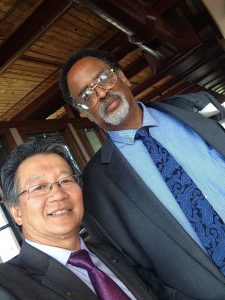
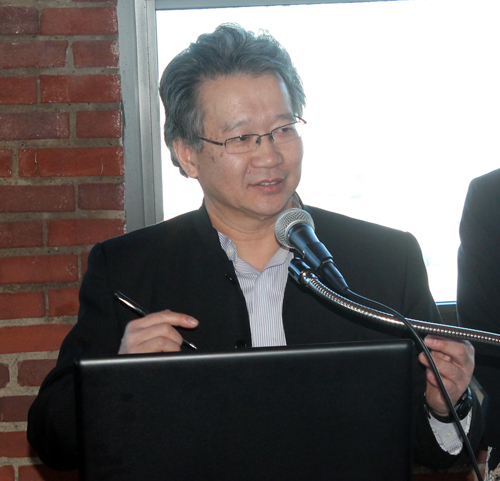
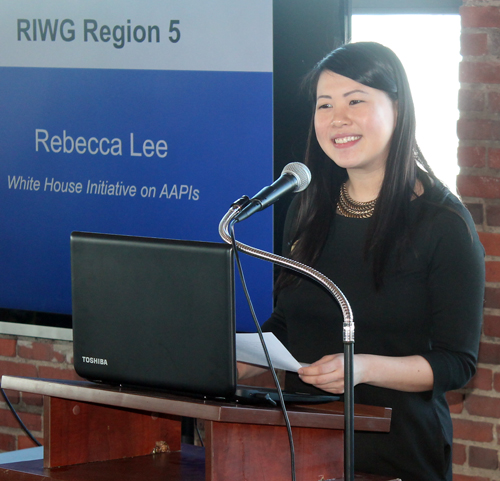
Cleveland Ward 14 City Councilman Brian Cummins
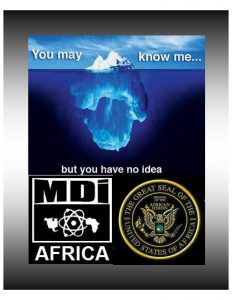 and
and 
The Bank of Japan (BOJ) expanded stimulus on on 9/16/2016 by doubling purchases of exchange-traded funds (ETF), yielding to pressure from the government and financial markets for bolder action. The BOJ maintained its base money target at 80 trillion yen ($785,658,400,000 USD) as well as keeping to the existing pace of purchasing other assets including Japanese government bonds. It left unchanged the 0.1 percent interest it charges on a portion of excess reserves that financial institutions park with the central bank.
By coordinating its action with the government’s promised $272 billion USD economic stimulus spending package, the BOJ likely aimed to maximize the effect of its measures on an economy that is struggling to escape decades of stagnation. We support our participation in the program that Japan is conducting with a powerful mix of flexible fiscal policy and quantitative easing. We believe that the government’s stimulus package helps reinforce this drive and is timely in achieving sustainable growth with price stability in the America’s, Africa and Asia.


